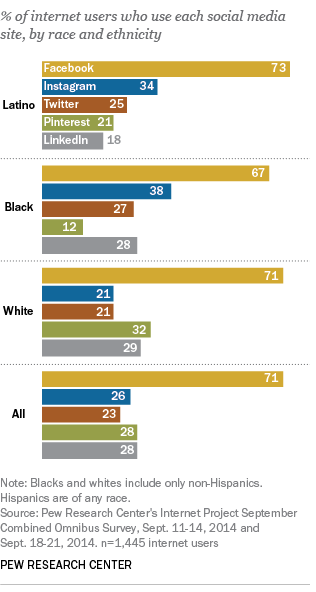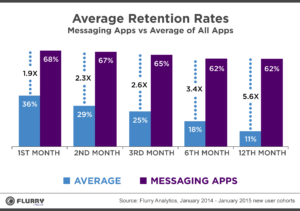Messaging app retention rates, magazine industry growth, social media preferences, how millennials get news, and more are covered in this month’s installment of TFP’s Media Metrics roundup.
To help you keep up with trends and prepare for changes just around the corner, each month we compile excerpts from some key reports covering issues affecting the publishing and media industries. Here are our top picks.
Study: Messaging Apps Get You Hooked, Keep You Coming Back for More (Social Times)
- According to a study by Flurry Analytics, the retention rates of messaging apps are 5.6 times better than the average app after 12 months.
- Daily frequency of messaging app use surpassed that of the average app by 4.7 times.
- On average, daily use of an app across all categories is 1.9 times, according to the data. Messaging apps are used nearly 9 times every day on average.
Magazine Media 360° Brand Audience Report Demonstrates Sustainable Industry Growth (Magazine Media 360°)
- According to the Magazine Media 360° Brand Audience Report, magazine media audiences were up 12.6% in February 2015 compared with February 2014.
- Gross magazine audience was 1.7 billion in February 2015, up from 1.5 billion in February 2014.
- Video and mobile web consumption was up 18.7% and 78.0%, respectively, over the same period last year.
- Web (desktop/laptop) was up 6.9%. Almost half of all websites in the report saw double- to triple-digit growth in unique visitors compared with last year.
 Who’s Using Which Social Network (Media Life Magazine)
Who’s Using Which Social Network (Media Life Magazine)
- The Pew Research Center found that Facebook is more popular among Hispanic and white Internet users (73% and 71%, respectively) than African American (67%) users.
- Some 38% of African Americans are on Instagram, compared with 34% of Hispanic and 21% of white users.
- Twitter use is higher among African Americans as well—27% compared with 25% and 21%, respectively, for Hispanic and white users.
- Pinterest, however, draws more white users (32%) than Hispanic (21%) and African American (12%) users.
Study: 69% of Millennials Follow News Daily (NetNewsCheck)
- The Media Insight Project found that 85% of millennials believe that keeping up with news is at least somewhat important, while 69% said they seek out news daily.
- Not surprisingly, it showed that the group finds news in diverse places, with 88% getting news from Facebook on a regular basis, as well as YouTube (83%), Instagram (50%), and sites such as Reddit.
- To find out more about news topics, 57% of millennials turn to search, as well as news sites (23%). Only 7% said they use Facebook for more in-depth reporting.
- Study participants also believe that using various sources of news exposes them to a wide range of opinions, with 70% saying that their social media feeds include diverse viewpoints and 73% reporting that they investigate others’ opinions at least some of the time.
Google Will Take 55% of Search Ad Dollars Globally in 2015 (eMarketer)
- Global digital ad spending will reach $170.85 billion in 2015, according to eMarketer.
- It projected search ads will take in $81.59 billion worldwide, an increase of 16.2% over 2014.
- By 2019, the search ad market will reach $130.58 billion globally, reflecting a growth rate of nearly 10% year over year.
- It projected Google’s search ad revenue will jump to $44.46 billion worldwide this year, a 15.7% annual growth rate that will bring its 2015 market share to 54.5%.
- China’s Baidu will see its share of search ad spending increase to 8.8% globally, up from 7.6% in 2014. Microsoft and Yahoo combined will account for just 6.5% of the global market in 2015.
Study: Young People Watch More Than 22 Hours of Online Video a Week (Adweek)
- Another study on millennials showed participants on average watched 11.3 hours of free online video on sites like YouTube and 10.8 hours of subscription video such as Netflix programming for a total of 22 hours of viewing time per week.
- On average, survey participants (1,350 people between the ages of 13 and 24) watched 8.3 hours of scheduled linear TV programming, with 6.4 hours of that online.
- Some 62% said they would rather view video content digitally than watch traditional TV programming. Nearly 70% said they relax by watching digital content, while 47% said they rely on television.
Funding to Media/Fat Content Startups Jumps 145% YoY (CB Insights)
- Digital news and media companies raised $813M in 2014 compared with $331 million in 2013.
- Year over year, funding for media startups spiked 145% in 2014.
- Digital news and media outlets that have received the most funding are Vice Media, Mode Media, Vox Media, BuzzFeed, and Business Insider.
Biggest Advertisers Are Sending Their Dollars to Digital (The New York Times)
- Data from Kantar Media shows large companies are cutting their ad budgets as they move to digital, with spending by the 10 biggest advertisers down 4.2% in 2014, to $15.3 billion compared with $16 billion in 2013.
- At newspapers, ad spending dropped 10%, with local papers seeing a decline of 11.6% and national newspapers staying flat, with a 0.3% drop in spending. Meanwhile, magazine ad expenditures were down 5.1%.
- Radio saw a 3.9% decline in ad spend, and outdoor fell 0.2%.
- Television fared better with increased ad expenditures in several areas, including cable (6.8%), network (2.5%), spot TV (5.5%), and Spanish-language TV (14.7%, an increase attributed in part to World Cup programming).
Tablets to Overtake Notebooks by 2016 (Digital Book World)
- While tablet sales have been declining, research from ABI projects that the category will hold 52% of mobile market share next year, while notebooks will account for only 47%, dropping from 51% in 2013. (Note: ABI’s “mobile computing device” category includes Windows laptops, Chromebooks, and ultraportable PCs but not smartphones. See report on smartphones below.)
- The report said while tablets remain popular, the category’s adoption rate is slowing, indicating that the devices don’t “serve the same purpose as notebooks.” The Chromebook and ultrabook category is expected to grow 47% this year and see a moderate compound annual growth rate of 16% from 2015 to 2020.
Smartphone Ownership Hits 64% in the U.S., Millennials ‘Heavily Dependent’ (Digital Book World)
- The latest Pew study on smartphone use found 64% of American adults are smartphone owners, a jump from 35% just four years ago.
- 15% of users in the U.S. reported that their smartphones are the primary way they access the Internet.
- Among 18- to 29-year-old users, 15% said they are “heavily dependent” on their smartphones, with 91% of that age group using their phones to access social sites.
- 68% read the news on their devices; 33% said they do so frequently.
40% of Email Clicks on Mobile (Media Post)
- Yesmail Interactive found mobile now accounts for nearly 40% of all email clicks, a 10% increase from Q4 2013 10 Q4 2014.
- Mobile click-to-open (CTO) rates increased more than 20% year over year, while desktop CTO went up 6%.
- In Q4 2014, 37% of all emails deployed incorporated responsive design, a 28% increase from the previous quarter.
- The report said CTO for emails optimized for mobile jumped 40% compared with campaigns that were not designed for mobile.
The Programmatic Advertising Report: Mobile, Video, and Real-Time Bidding Drive Growth in Programmatic (Business Insider)
- A BI Intelligence report put total U.S. programmatic ad revenue at nearly $15 billion this year. Programmatic will account for a majority (52%) of non-search digital ad spending for the first time this year.
- It estimated that 30.6% of total digital ad spend will be via programmatic real-time bidding (RTB) platforms, while 21.7% will be non-RTB programmatic transactions.
- More than four-fifths of agencies and brands will buy display ads via programmatic, and “an even greater proportion of publishers are pursuing programmatic channels as part of their sales strategies,” the report said.
- With a compound annual growth rate of 24%, RTB is growing even faster than programmatic overall. RTB revenue will jump from $8.7 billion this year to $26 billion by the end of 2020.
Media Metrics is a monthly feature from Technology for Publishing, aimed at keeping you armed with the latest industry data. If you’d like to share something you’ve read, drop us a note. And keep up with the latest industry news coverage by signing up for our This Week in Publishing emails or our monthly Publishing Trends newsletter.
Posted by: Margot Knorr Mancini



